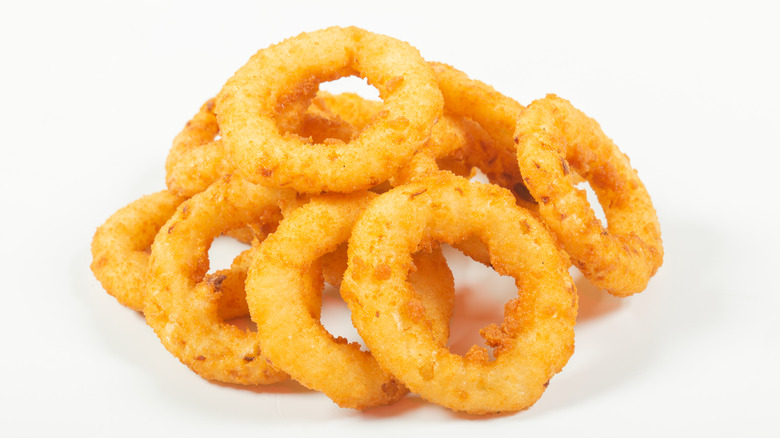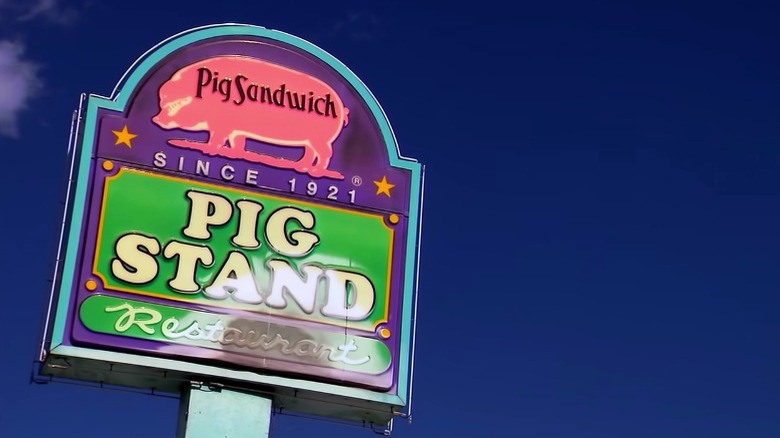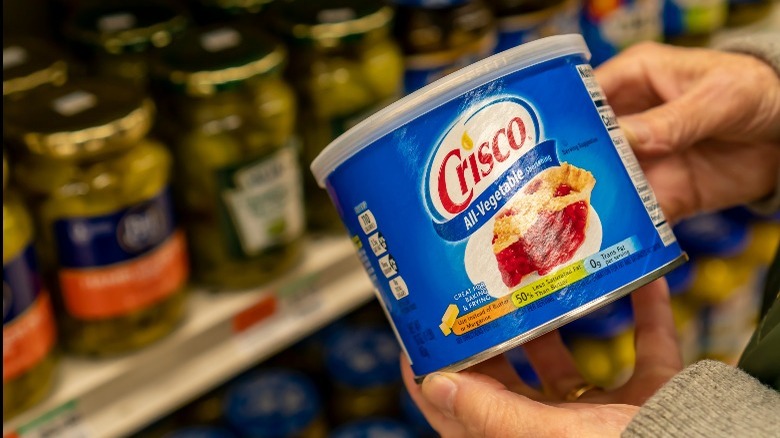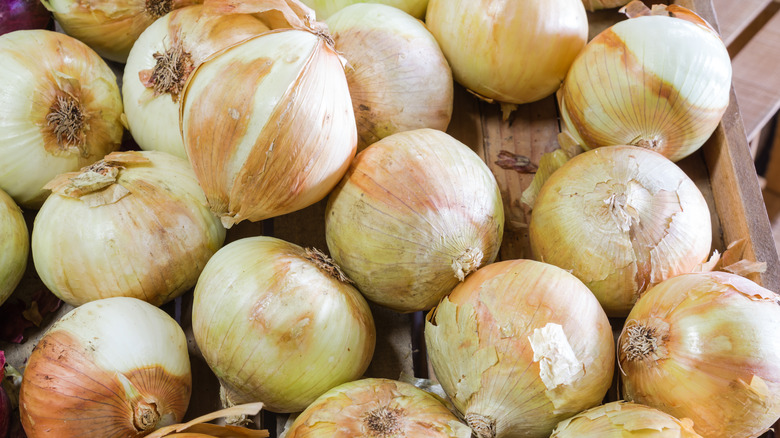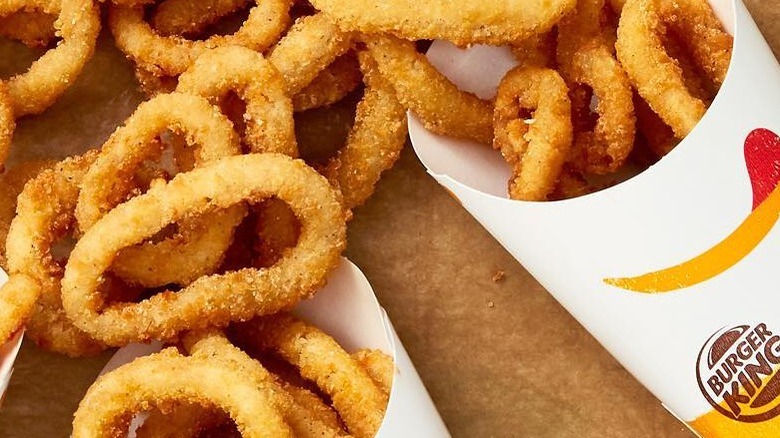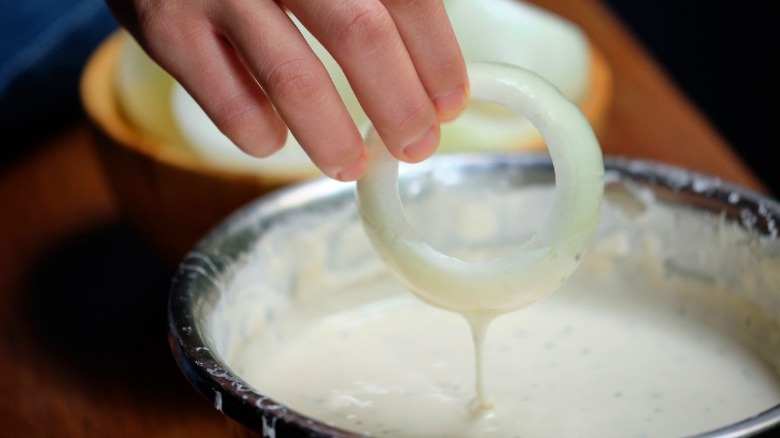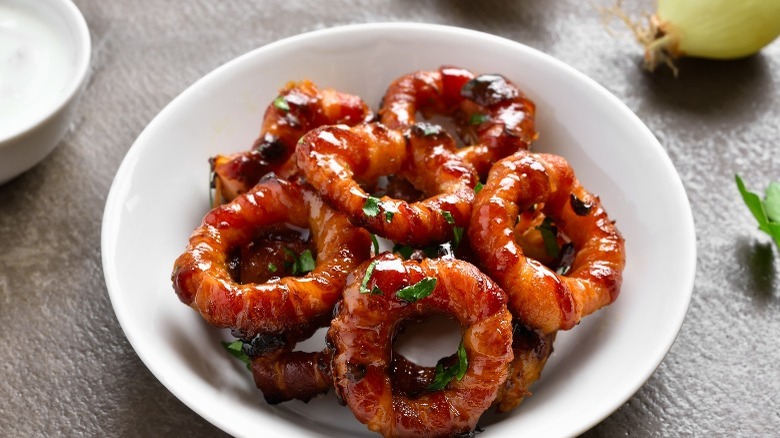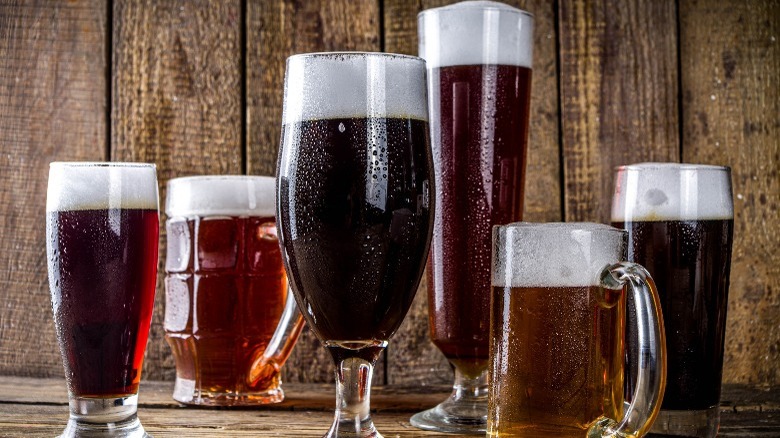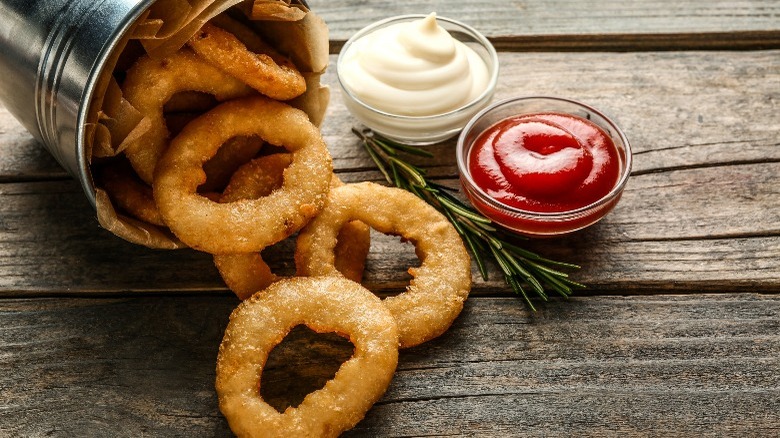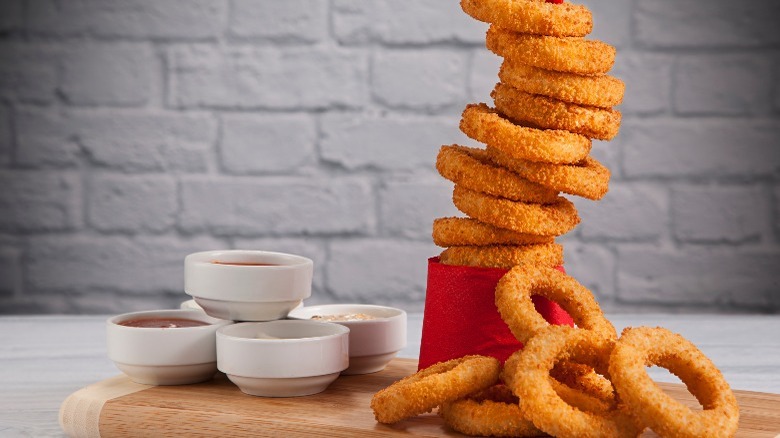The Untold Truth Of Onion Rings
Ordering onion rings is kind of like shopping at a thrift store. It's more unconventional than, say, ordering fries or heading to a retail outlet. There's a wide range of quality in the product — it can be a delight or a disaster. And the actual history of what you get is up in the air.
It turns out that the roots of onion rings are as flimsy as, well, a poorly constructed onion ring. Several countries' culinary histories include the concept of deep frying vegetables, so it gets a bit dicey (or, perhaps more appropriately, slice-y) when pinpointing an exact time and place for the dish's exact origin. No matter where or when they came from, we can at least agree that a well made onion ring is a gastronomic triumph, and we should be thankful for them. Read on to learn more about what we do know about onion rings' true origins, plus some important factoids to consider about the crunchy-yet-greasy, salty-yet-sweet side.
Onion rings are allegedly a British invention
The genesis of the onion ring is up for debate, though we do have a few clues based on historical texts. In the 1802 cookbook "The Art of Cookery Made Easy and Refined," author John Mollard offers "ample directions for preparing every article requisite for furnishing the tables of the nobleman, gentleman, and tradesman." Among those requisite articles: "fried onions with Parmezan [sic] cheese." So say what you want, haters: Onion rings are the food of nobles. In the recipe, Mollard walks the reader through more or less how an onion ring would be prepared today, though he adds a bit of finely grated cheese to the breading and fries them in lard.
Of course, Mollard wasn't the first person to pick up an onion and think to toss it in the fryer. The Indian snack pakora, in which vegetables (onions included) are coated in a chickpea flour batter and deep fried, dates back to at least the 16th century, according to The Hindustan Times. The dish also paved the way for tempura, as Spanish and Portuguese traders sailed from India to Japan.
Multiple U.S. states also lay claim to them
John Mollard may have published one of the first onion ring recipes in the early 19th century, but that doesn't explain how they gained prominence in the United States, or why that didn't really happen for another hundred years.
Etymologist Barry Popik tracked down a handful of places in which onion rings, also referred to as "French fried onions," made appearances in America, the earliest of his findings being a 1908 recipe by Fannie M. Farmer in the Fort Wayne Sentinel. In 1910, a recipe in the New York Sun calls French fried onions "a novelty that progressive New York restaurants are introducing with great appreciation from their patrons."
It's important to note that both of these references precede the 1921 opening of the Texas-based Pig Stand, which has been hailed in various publications as the birthplace of the onion ring, according to The History Channel. The establishment was a pioneer in several ways (including being the first drive-in restaurant), but onion ring creator it was not. It's possible Pig Stand popularized the actual term "onion rings," though a 1939 menu (via WorthPoint) appears to still call them French fried onions (priced at 10 cents — what a time!).
Crisco played a part in their popularity
Among the first widely published recipes for onion rings was courtesy of an advertisement for Crisco, published in The New York Times Magazine in 1933. In it, two illustrated women share their love for onion rings, which indicates that the food was hardly newfangled but perhaps less commonly made in home kitchens. The copy reads, "Mrs. Tasker used to get upset stomachs from fried food, but thanks to Crisco, she can now digest them easily!" In retrospect, the ad is kind of hilarious, touting Crisco (in all its trans fat glory) as a "healthful" vegetable fat.
The appeal of Crisco and onion rings during the Great Depression may have something to do with what's left unsaid in the ad as well. It was derived from the relatively cheap cottonseed oil (one of the reasons people eventually stopped buying Crisco), which made it a much more budget-friendly purchase than butter or lard; the fact that it was vegetable-based (albeit using the term "vegetable" very loosely) was an added bonus. Onions were also an affordable ingredient and often used as an inexpensive way to bulk up a meal. And onion rings sound far more palatable than another delicacy at the time: peanut butter-stuffed onions.
Certain onions make better rings than others
Not all alliums are created equal. Leeks may be delicious in a soup or braise, but good luck trying to turn them into onion rings. Shallots make a beautiful crunchy topping when fried, but their tiny frame and shape will make it nearly impossible to yield a ring suitable for dredging and battering. If you want onion rings, bigger tends to be better.
But a good onion ring relies on an onion that's more than just size. Flavor is critical as well; use the wrong onion and you're left with deep fried pungency instead of a golden brown delight. Foodsguy notes that white and yellow varieties are decent picks, but for optimal onion rings, go for sweet onions (such as Vidalia or Maui). These kinds don't have as strong of a sulfuric taste, and frying them brings out their caramelly aromas. If you're short on sweet onions, you can tamp down the potency of other types by soaking the sliced rings in ice water.
Onion rings don't always contain actual rings of onions
Beware: Some restaurants may be doing some Olympics-level linguistic gymnastics when they sell you what they call onion rings. For instance, while the natural thing to assume when one hears "onion rings" is that we're talking about pieces of onion sliced into rings, Burger King instead opts for a ring-shaped blob made out of a pasty substance that vaguely tastes like onion.
A look at the ingredients for Burger King's onion rings indicates that indeed, the only actual onion products present are dehydrated onion and onion powder (via Fooducate). Onion ring reviewers (dream job?) at The Village Voice and GrubGrade have said that this leaves you with a whole lot of breading and very little flavor.
If you believe life's too short for onion rings that don't actually contain rings of onions, you're not alone. Noted onion ring connoisseur Lorde graded Burger King's offering a one out of five, adding in her Instagram post that they contained "a mulched onion filling with a distinct bitterness."
There are two schools of thought when it comes to breading
You can look up a dozen different onion ring recipes and you'll get about as many methods of prepping them for the fryer. But at the end of the day, there are two main paths you can go down: a batter dredge and a crumb dredge. You'll get slightly different textures in the end, but both involve coating the raw onions before tossing them into the hot oil. And both methods are delicious.
Food and Wine opts for the former, recommending a combination of flour, cornstarch, baking powder, and salt, which is then stirred into club soda until it creates a mixture a little thinner than pancake batter. The sliced onion rings are then dunked in the batter before hitting the fryer. The batter method creates an even, golden, crackly shell around the onion ring, and Food and Wine's version incorporates some ingredients that help create a light and crispy final product. Cornstarch absorbs moisture and prevents gluten formation, while the carbonation in the club soda lightens up the batter (via ChefSteps).
Meanwhile, Allrecipes suggests a crumb dredge, calling for the rings to be tossed in flour, dipped in egg wash, then coated in breadcrumbs. This is known as a dry, wet, dry dredge, and will give you a crust similar to that of chicken nuggets. Since the outermost coating is dry (as opposed to a dripping batter), this is also a good option if you're using a baked onion rings recipe (try it with panko breadcrumbs for extra crunch!).
Bacon is a breading alternative, apparently
Of course, there's a way to skip breading altogether, though it's not exactly kosher, so to speak. One method skips breading altogether and wraps the onion rings in ... bacon. Bacon is to cooking as Cousin Oliver was to "The Brady Bunch." It's frequently added to shake things up and spark some excitement, but all too often it's an unwelcome, underwhelming, and cliché move. And yet — it makes a lot of sense here. The onions in onion rings are (ideally) pretty sweet, so bacon's saltiness counters that. Bacon loves to get crispy, and that's what we're looking for in an onion ring. And hey, it's low carb.
If you want to try bacon onion rings for yourself, you've got options. One breadingless route, from Delish, simply involves wrapping bacon strips around the rings then baking (a cayenne and brown sugar rub creates a sweet and spicy kick). Food Network's version is even simpler, with two ingredients: bacon and a package of frozen onion rings.
Buttermilk and beer both play important roles for the batter
There are two liquids that can act as onion rings' secret weapon, and you'll frequently see at least one of them at play. Bon Appétit actually uses both. We're talking about the two B's: buttermilk and beer.
Buttermilk contains acidity, which works as a tenderizer. This is why it's a natural fit for fried chicken, and yes, even onions. That acidic tang also helps cut through the fat content of fried food, so they don't feel as heavy. Additionally, buttermilk's viscosity is an asset when dredging, as dry ingredients will stick to it more easily.
Another common ingredient when frying, especially in batters, is beer. Beer batter is a staple in all sorts of pub fare (fish and chips, anyone?), and not just because you're always within arm's reach of some ale. Scientific American walks through the chemistry behind the method, explaining that in addition to adding carbonation, beer also adds alcohol, which evaporates faster than water and therefore allows the batter to crisp up before whatever it's coating overcooks.
What you dip them in might depend on where (and when) you live
An onion ring just isn't complete without at least one condiment. Onion ring founding father John Mollard even knew this, adding at the end of his 1802 recipe, "melted butter with a little mustard in it to be served in a sauce boat." As delectable as that sounds, we've since moved on to another dipping sauce of choice. The combination of ketchup and mayonnaise is a popular concoction around the world, but it goes by many different names.
A Utah fast food chain dubbed it pink sauce before it became more widely known in the U.S. as fry sauce (via Atlas Obscura). In South America, it goes by salsa golf (via Food52). The U.K. calls it burger sauce, throwing in a squeeze of mustard and chopped pickles. Pour it over salad and call it Russian or Thousand Island dressing.
The Germans, however, with their Thomy-brand Rot Weiß, go full Willy Wonka. Translated into English as "Red White," the product looks more like toothpaste than a condiment. It comes in a squeeze tube, and the ketchup and mayo come out in distinct, intertwined stripes. No doubt it goes great with onion rings or any other fried side, but Rot Weiß also sounds like a fantastic April Fool's purchase.
Sonic's onion rings contain a unique secret ingredient
There are some components of onion rings you'll almost always run into: onions (or some sort of oniony paste), a dredge or batter situation, frying oil. But one fast food chain reportedly throws in something unexpected. A former Sonic employee revealed on the Copykat blog that the secret ingredient Sonic uses in its onion rings is vanilla ice milk mix ("but using melted vanilla ice cream works just as well," she assures).
In theory, the questionable ingredient makes some sense. For one, dairy often plays a part in onion ring batter (see: buttermilk). Secondly, onion rings do benefit from a bit of sweetness to offset the pungent onion flavor. Normally, this would be achieved by using a sweet onion like a Vidalia. However, yellow onions are considerably cheaper than sweet onions in many parts of the U.S. (according to Onion Business). So incorporating vanilla ice cream could be a way for Sonic to use what they've got to cut back on costs.
Admittedly, the particular flavor combination of vanilla and onion doesn't sound that enticing, and as it turns out, Sonic's rings are near the bottom of Mashed's ranking of fast food onion rings in part for this reason.
Onion rings played a part in a drug bust
Onion rings make a great side. They make a great burger topping. They're there for you when you need to be shaken out of french fried monotony. There's just one thing onion rings will refuse to do: conceal a massive amount of hard drugs.
In 2021, U.K. border control officers stationed in France stopped a driver and discovered 418 kilos of cocaine — street valued at an estimated $44 million — in his truck. The British National Crime Agency shared that the contraband was hidden in shipping boxes and (unsuccessfully) concealed by bags of frozen onion rings. The driver was charged with smuggling and was ordered to appear in court. The NCA report does omit one crucial detail that some Twitter users pointed out: the fate of the onion rings.
Some old-fashioned zoom-in-and-enhance sleuthing indicates that the onion rings used as decoys were from Aldi's Four Season. For what it's worth, this U.K. vlogger says the product is actually "really, really nice" — to eat, that is; not to abet in drug trafficking.
There is an actual Onion Rings Day
June 22 is an important day in American history. In 1870, Ulysses S. Grant enacted the formation of the Justice Department. In 1942, the Pledge of Allegiance was formally instituted. In 1949, Meryl Streep was born. It's also National Onion Rings Day. Mark your calendar.
The actual reasoning behind why June 22 (or any day, for that matter) is dedicated to onion rings is up in the air. Also unclear is how this momentous occasion even started. The National Onion Association first recognized and acknowledged the holiday in 2014, and for that, we are eternally grateful. What's the best way to celebrate? "With a batch of homemade onion rings or with family and friends at a local restaurant," the NOA proclaims. "Be sure to order a basket or two with your favorite dipping sauce."
Frankly, National Onion Rings Day should be a national holiday. Banks should be closed. Children should have the day off from school. Onion rings should be on every table.
